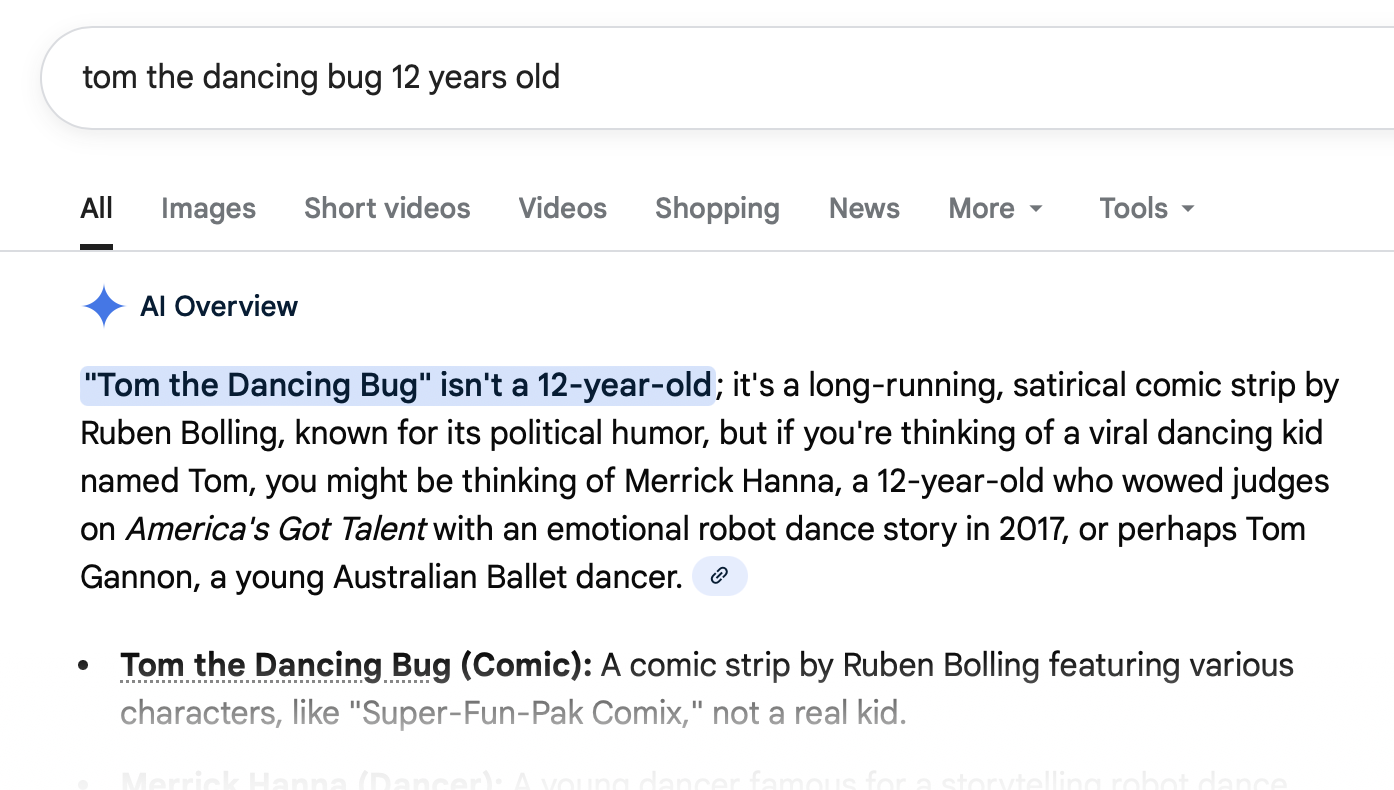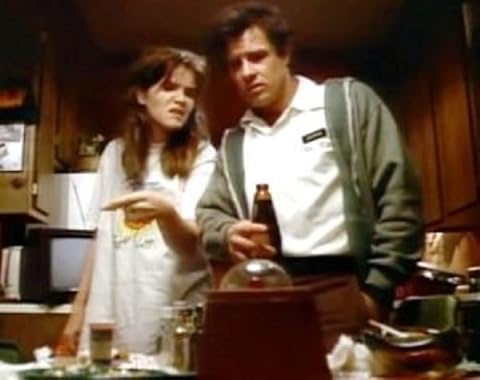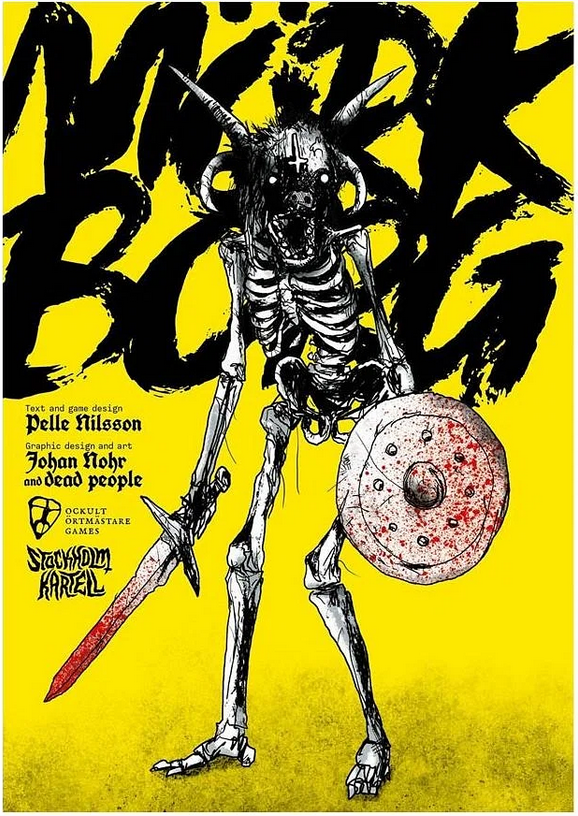Bicameral Google is unpleasant
Here is the specific reason I find Google so actively unpleasant to use today: we have all been trained for literally decades on how to “speak Google” by typing space-separated lists of keywords and phrases into the famous search bar, and then using the resulting page of “hits” to either find what we need, or to iteratively refine our search query. And you can still use Google like that, more or less. But, in many-perhaps-most cases, the top search results get preempted by the “AI Overview” answer, which reads your query completely differently.

The attached screenshot shows a detail of my trying to locate the particular Tom the Dancing Bug comic strip that I wanted to hyperlink to from my previous ’Twas This post. The first actual hit took me straight there, in remarkably classic Google fashion. But before that, I had to have the AI respond to me as if I had rolled up to a chatbot and said “Duhhh, Tom the Dancing Bug… twelve years old?!” out loud, barely able to string words together. Because I wasn’t trying to string words together! I was typing in a search query! Into a search engine! Which is not a chatbot!
But that’s why I once again got a bizarrely insulting answer from Google’s AI Overview treating me like a grunting simpleton. Today I apparently wanted to know about a 12-year-old named ‘Tom the Dancing Bug’, and so it assured me no such person exists—ho ho, that’s the name of a comic strip, not a real child, silly human!—and suggested other 12-year-olds I might have been looking for instead.
Maybe Google wants us to stop using Google like Google and just type in complete sentences now, ending in question marks. Is this how everyone on earth already uses it except for me, my narrow band of friends, and William Riker? Maybe! I don’t know! But if not, I feel like Google needs to, I dunno, put some re-training information out there or something.
Button, Button
 I am eating my way through a wonderful Penguin edition of the best Richard Matheson short stories, and just read “Button, Button”, the basis for my very favorite episode of the 1980s Twilight Zone revival. I didn’t know before yesterday that it was a Matheson original, but I’m not surprised; he also wrote the indelible 1960s Twilight Zone episode “Nightmare at 20,000 Feet”, which I’ve written about elsewhere recently.
I am eating my way through a wonderful Penguin edition of the best Richard Matheson short stories, and just read “Button, Button”, the basis for my very favorite episode of the 1980s Twilight Zone revival. I didn’t know before yesterday that it was a Matheson original, but I’m not surprised; he also wrote the indelible 1960s Twilight Zone episode “Nightmare at 20,000 Feet”, which I’ve written about elsewhere recently.
But I immediately disliked Matheson’s story! Its ending is radically different from the TV show’s, and the TV show’s ending hit me right where I lived at age 12. It had exactly the right amount of subtlety for a 12 year old, and because I was 12 it was therefore instantly the most unforgettably amazing thing I’d ever seen. I told my family and my friends at school about how cool this episode was, summarizing the whole plot for them.
The silly twist ending of the original printed story has nothing on the TV version! Had I never seen the episode I probably would have said “lol” and moved on, but instead I was brought from the amazing high of discovering the source material to one of my all-time favorite TV moments, only to get this womp-womp ending. Wow.
(The two endings are discussed on the TV epsiode’s Wikipedia page.)
Hidden messages in shiny covers
Two physical books I purchased while traveling last month, the RPG rulebook Mörk Borg and the Jeff VanderMeer novel Borne, have something in common on their covers, neither of which I discovered until well into my ownership of either: “secret” images or messages, applied in some kind of clear material that is literally invisible in direct light but shines when viewed obliquely.
The spine of Mörk Borg has hidden letters interleaved among those of the book’s title, running down its spine, spelling “P S A L M VII”. This is a reference to the Final Misery of the game’s setting, the inexorable doom that that shall bring an end to all other suffering through one last dreadful eclipse, and of which I shall write no more.
The front cover of Borne is a little more subtle; the reader might notice some uncertain streaks around the edges of the softcover book’s artwork, and take them as just part of the cover’s already surreal and ambiguous portrait of the eponymous shapeshifting creature that the book’s plot turns on. But sooner or later they’ll happen to glance at the cover while the book lay closed on their tabletop, and see the gaping, roaring maw of a bear lunging at them, aieee! This being a reference to the novel’s main antagonist. Who is a bear.
I don’t at present know what this printing technique is called, but it seems to be a trend. It’s fun.
Borne is great, by the way. It’s set in a post-apocalyptic world of uncertain identity, where—as in Mörk Borg—things are so hopelessly teetering on the end that the straggling survivors often don’t bother naming things. There is only “the city”, lying in hopeless ruin, drowning in bio-engineered poisons and horrors. No characters have any sense of shared civilizational history, beyond cloudy personal memories they carry. So when a young scavenger finds a strange and warm green lump tangled in the filthy fur of the kaiju-sized flying bear she’s picking through for salvage, she is overwhelmed with novelty, and takes it home, and names it, and falls in love with it. And then things get complicated.
Compared to VanderMeer’s Southern Reach trilogy, from a decade ago, Borne has a traditional structure and a straight-shooting narrator, and I can generally recommend it to all enjoyers of modern weird fiction.
Could I get a hat wobble?
One of the runaway bits from Tim and Eric Awesome Show, Great Job! is a 90-second skit featuring Paul Rudd sitting businesslike at a PC workstation floating in a futuristic space, directing the computer by conversational, spoken commands to resume iterative work on a long-form creative project.
The skit first aired in the early 2010s, and so part of the humor comes from the perceived impossibility of directing a computer this way. It’s something of a parody of how “computer programming” or otherwise making stuff with computers has long been depicted across countless films and TV shows, and which my friends and I have spent much of our professional lives rolling our eyes at.
And here we are in 2025 and this is what working with a computer feels like to me now—at least with certain kinds of creative projects, especially code-intensive ones. I’m not quite at speaking out loud yet, but I absolutely do get comfortable with my coffee, type out a greeting to Claude Code, and start describing in plain, written English—sometimes with sketched-out illustrations or ASCII-art mockups—what I want to accomplish that session. This work quickly drills down into “4d3d3d3”-type implementation details that would be inscrutable to any observer. On a productive day, the machine and I bat some design concepts and code changes back and forth for several hours, and end with some co-authored Git commits.
And that’s why sometimes when I get into a disagreement with Claude on some matter, I’ll clear my throat and mutter “Nude Tayne” out loud, leaning in and pronouncing it very emphatically.
Down in the mörk

I spent last weekend at PAX Unplugged in Philadelphia. It had been a long time since I’d last attended a tabletop gaming conference of any kind with my game-loving partner, and I pushed to have us attend this, both because-of and despite how it slotted perfectly between two other interstate trips that filled out most of November for us. We traded away a chance to catch our breath at home for several days of exhausting overstimulation that reminded me why I love non-digital games at least as much as video games, and caught me up on recent trends and innovations I’d been missing. It was a terrible idea, and I regret nothing.
One thing I learned about was Mörk Borg, a loud but minimalist tabletop role-playing game system by Pelle Nilsson and Johan Nohr of Sweden. Its design and aesthetic—of the game’s rules, and of its slim, hardbound, bright yellow rulebook—draw heavily from the native music of the designers’ home country, by which I mean black metal. While certainly not the first marriage of fantasy TTRPGs and metal I’ve encountered, it is the first example of the so-called New School Renaissance that has spoken to me.
Here’s me trying to explain my interest to someone in a group chat the other day:
Eyes go glassy Mörk Borg—technically pronounced something like “Murk Bory” but I understand the Swedish designers to recognize an “official compromise” of “Murk Borg”—is an example of the so-called “New School Renaissance (NSR)”, an extension of the earlier “Old School Renaissance” led by grognards who missed the pace and flavor of decades-past D&D and other ancient TTRPGs. NSR games try to remix the attitude of older games with newer philosophies and innovations in game design.
Mörk Borg, in particular, emphasizes a fast-play, rules-light stance with a broadly sketched but highly evocative apocalyptic setting inspired by doom metal. The designers have opted to hold its IP loosely, resulting in a flourishing of third-party content for it in just the last few years. At PAX Unplugged there were so many vendors selling Mörk Borg supplements that one of them set up a scavenger hunt just to visit them all. Complete-system offshoots designed by other entities include CY_BORG and Pirate Borg.
It is my dream to run at least one Mörk Borg adventure before the final Misery is rolled, the prophecy of Psalm VII is fulfilled, and the face of the black disk Yetsabu-Nech covers the sun, and a darkness swallows the darkness forever. Collapses into a pile of mouldering bones
So, yes, all of that. The rulebook—a riotously laid-out affair that reminds me of nothing so much as The Book of the Sub-Genius or The Principia Discordia—includes a starter adventure called “Rotblack Sludge”, and I am practicing by playing it solo with generative-AI assistance, treating the chatbot as a group of players at my table. The bot’s constant forgetfulness and bad dice-math interspersed with moments of surprising insight makes for a suitable GM training dummy, I find.
Welcome to America (actually)
At least a couple people in my friend-sphere are today becoming or have recently become U.S. citizens.
If you’re American and this is true for you too, I encourage you to put aside irony and bitterness and instead hold the thought: Look, see, the project is still alive. May their addition to it be a candle through the darkness.
Update: New citizens are shown a speech by the current president at their naturalization ceremony. One friend describes it as “awful beyond description; like, Lynchian”. After a friend of had to watch it earlier this year, Daniel D. Beck shared his own alternative welcome message to new citizens.
Liberals, liberals, liberals!
I try not to make a habit of peeking at the trending-posts tab of my Mastodon server, but when I do it anyway, I often find myself thinking of the preceding 2005 installment of “Anthropomorphic Republican Talking Duck”, a “Mallard Fillmore” parody by Adam Jameson.
There are over 300 million Americans so I’m sure that some must self-identify as “liberal”, but I’m not certain I’ve ever met any. It’s a little funny to me how this right-wing bogeyman has been wholly co-opted by the left wing as well, or at least that part of it which is angriest and loudest in my nearest shards of current American culture.
Coyotes on two coasts
Janet Kessler lives in San Fransisco and maintains Coyote Yipps, a blog that documents her observations about the local coyotes living their lives. Her most recent post features a coyote dad musically summoning its family before beginning the evening together. My favorite post is a photo collection of a young, solitary coyote who digs up a clearly beloved toy on a golf course, plays energetically with it, then re-buries it. It has a sad angle; Kessler tracks and observes these animals well enough to know their individual stories, including how this one had recently lost its brother and playmate.
Closer to (my) home, I enjoyed this profile about Romeo and Juliet, a coyote couple who lives in Central Park, by Bonnie Eissner for the West Side Rag. Their territory includes Delacorte Theater, best known for its annual free Shakespeare performances—and hence the name of these two animals. The article has several great photos of the pair, including a shot of them nuzzling affectionately while on-stage together.
I have a certain fondness for coyotes, some of whom I glimpse from time to time in my late-night Central Park walks. (I left a comment about one such encounter on the Rag article.) Very American animals, urban and resilient. I like thinking of them as neighbors.
Bringing up the conversation UI
Sometimes I feel the urge to say something snide, cutting, or otherwise intentionally hurtful to someone I love. It may come in response to some perceived slight or annoyance, or in shock and retaliation for something hurtful they just said. The words rise up my throat in a peristalsis of emotion, and it takes an act of will to delay their expulsion.
After I buy myself some time like this, I reframe my situation this way: What if I saw the words now trying to pry open my jaw as instead glowing in front of me, one of several choices I could make in a video game’s conversational interface?
I immediately know that, in a game, I’d gleefully choose the cued-up acerbic utterance if I wanted to start a fight, or if I decided that my character didn’t like or respect the other character. Or maybe I was just screwing around, exploring how much I could break the game through awful choices, with the intent to reload a save file afterwards.
Invariably, none of these motivations apply to my real-life situation, and the “characters” involved. So, clearly, I shouldn’t choose this option. So what are the other choices? There’s always at least two or three to pick from, right? Still in this frame, I find it easier to read—that is, mentally compose—at least a couple of cooler-headed alternative replies, there in my imaginary conversational UI. (Including, often, the ever-popular [Say nothing].) And I choose one of those instead, and life goes on—with no yearning, moments later, for a Quick Load button.
Cursed weapons
In A Haunting Relic From America’s Past, Wright Thompson describes his encounter with the Army-issued pistol that was used to beat and murder 14-year-old Emmett Till in 1955. Thompson located the gun while writing a book about the context and legacy of that murder. Subsequently, the person who had inherited it—a local crop duster—donated it to the Mississippi Civil Rights Museum, where it just went on permanent display.
Thompson describes the menacing energy the gun emanates, viewed in person. He quotes multiple museum employees expressing similar sentiment.
Goodwin met the pilot for the handoff. The gun came wrapped in a rag inside a plastic Kroger shopping bag. Goodwin held it. He wished he hadn’t. That night he struggled to sleep.
As a lifelong enjoyer of fantasy books and games, it humbled me to encounter this description of a specific gun that radiates an actively hateful aura: an actual, real-life cursed weapon. One powered not by evil wizardry, but human-scale horror, and hate.
I first read this article on my phone while on jury duty, last week. The text moved me, while its illustration on my tiny screen seemed unremarkable. Returning to write this entry now, I have the story opened on my desktop display, and I find that the full-sized photograph of the gun and its holster absolutely radiates some of that malice. I feel it in my spine, and I reflect on why that’s so.
’Twas This is a notebook by Jason McIntosh. It has an RSS feed, and accepts responses via Webmention. For longer-form writing, see Fogknife.
This blog's social-media links use a detail of the photograph "Der Anfang eines neuen Quilts?" by creativekitty, licensed under CC BY-NC 2.0. This blog is powered by Plerd. Thank you for your time and attention today.

 jmac@jmac.org
jmac@jmac.org @jmac@masto.nyc
@jmac@masto.nyc